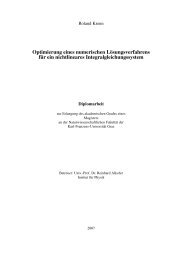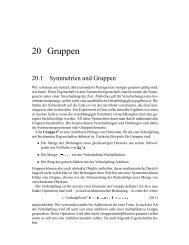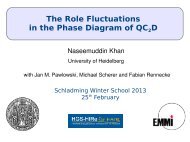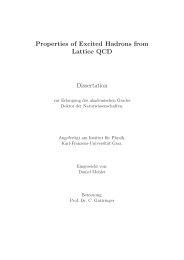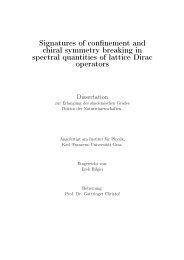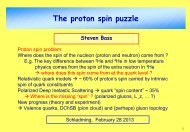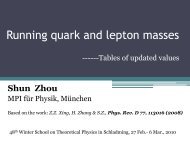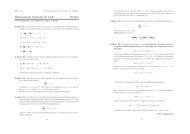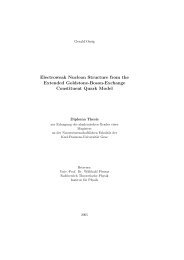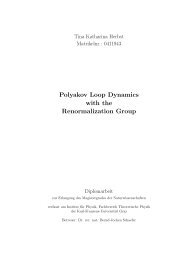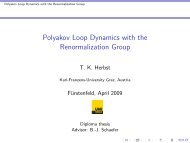The QCD Quark Propagator in Coulomb Gauge and - Institut für Physik
The QCD Quark Propagator in Coulomb Gauge and - Institut für Physik
The QCD Quark Propagator in Coulomb Gauge and - Institut für Physik
Create successful ePaper yourself
Turn your PDF publications into a flip-book with our unique Google optimized e-Paper software.
72 6.4. Electromagnetic current operator<br />
For a po<strong>in</strong>tlike axial-vector we have µ 1 + = 2; <strong>and</strong> χ 1 + = 1, which corresponds to an oblate<br />
charge distribution. In addition, equations(6.64)–(6.67) with equations(6.72)–(6.74) realise<br />
the constra<strong>in</strong>ts of reference[BH92], namely, <strong>in</strong>dependent of the values of µ 1 + <strong>and</strong> χ 1 +,<br />
the form factors assume the ratios<br />
G 1+<br />
E (Q2 ) : G 1+ M (Q2 ) : G 1+<br />
Q (Q2 ) Q2 →∞<br />
= (1 − 2 3 τ 1 +) : 2 : −1 . (6.78)<br />
6.4.3 Coupl<strong>in</strong>g to the exchanged quark<br />
Diagram 3 depicts a photon coupl<strong>in</strong>g to the quark that is exchanged as one diquark breaks<br />
up <strong>and</strong> another is formed. While this is the first two-loop diagram we have described, no<br />
new elements appear <strong>in</strong> its specification: the dressed-quark-photon vertex was discussed<br />
<strong>in</strong> section 6.4.1. <strong>The</strong> explicit contribution to the vertex is obta<strong>in</strong>ed with<br />
J ex<br />
µ = −1 2 S(k q)∆ i (k d )Γ i (p 1 , k d )S T (q)ˆΓ quT<br />
µ (q ′ , q)S T (q ′ )¯Γ jT (p ′ 2 , p d)∆ j (p d )S(p q ) , (6.79)<br />
where<strong>in</strong> the vertex<br />
ˆΓ<br />
qu<br />
µ<br />
appeared <strong>in</strong> equation(6.54). <strong>The</strong> full contribution is obta<strong>in</strong>ed by<br />
summ<strong>in</strong>g over the superscripts i, j, which can each take the values 0 + , 1 + .<br />
It is noteworthy that the process of quark exchange provides the attraction necessary <strong>in</strong><br />
the Faddeev equation to b<strong>in</strong>d the nucleon. It also guarantees that the Faddeev amplitude<br />
has the correct antisymmetry under the exchange of any two dressed-quarks. This key<br />
feature is absent <strong>in</strong> models with elementary (noncomposite) diquarks.<br />
6.4.4 Scalar ↔ axialvector transition<br />
This contribution differs from diagram 2 <strong>in</strong> express<strong>in</strong>g the contribution to the nucleons’<br />
form factors ow<strong>in</strong>g to an electromagnetically <strong>in</strong>duced transition between scalar <strong>and</strong> axialvector<br />
diquarks:<br />
[ˆΓdq<br />
ij<br />
Jµ dq = ∆ i (p d ) µ (p d ; k d )]<br />
∆ j (k d )S(k q )(2π) 4 δ 4 (p − k + ηQ) , (6.80)<br />
where [ˆΓ dq<br />
µ (p d ; k d )] i=j = 0, <strong>and</strong> [ˆΓ dq<br />
µ (p d ; k d )] 1,2 = Γ SA , which is given <strong>in</strong> equation(6.81), <strong>and</strong><br />
[ˆΓ dq<br />
µ (p d; k d )] 2,1 = Γ AS . Naturally, the diquark propagators match the l<strong>in</strong>e to which they<br />
are attached.<br />
<strong>The</strong> transition vertex is a rank-2 pseudotensor <strong>and</strong> can therefore be expressed<br />
Γ γα<br />
SA (l 1, l 2 ) = −Γ γα<br />
AS (l 1, l 2 ) =<br />
i<br />
M N<br />
T (l 1 , l 2 ) ε γαρλ l 1ρ l 2λ , (6.81)



